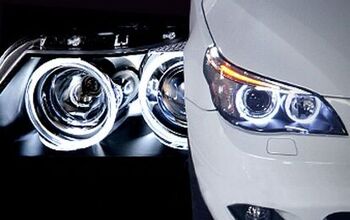German is Beautiful
“Small is Beautiful” was released immediately after the ’73 energy crisis. German economist E. F. Schumaker’s collection of essays tapped into the prevailing gestalt: a growing fear that the institutions that defined capitalism’s success had become economically and environmentally unsustainable. Contrary to popular belief (i.e. the people who used the book’s title as a mantra without reading it), Schumaker wasn’t predicting or recommending the end of big business. He simply believed that large organizations work best as small, independent groups acting in harmony. Someone ought to tell Dieter Zetsche.
"We are convinced that DaimlerChrysler provides [Chrysler with] more resources [and] know-how [than its competitors] in many areas," DCX' CEO pronounced at yesterday’s US launch of the German-engineered Smart two-seater. In case you missed the point of Dieter’s diatribe, the carmaker is launching an advertising campaign tomorrow that touts the fact that Chrysler products benefit from German – American cross-pollination. In short, a Chrysler is a better car than a Ford or GM vehicle because it’s got Mercedes DNA.
There are some obvious problems with this strategy. Mercedes’ reputation for bullet-proof build quality is long gone, squandered in the relentless pursuit of growth and cost-paring profit. (Proclaiming that a Chrysler is built like a Merc will cause many a previous gen S-Class owner to smirk uncontrollably.) Toyota, Lexus, Honda and Hyundai have a far more credible and accessible claim to mechanical reliability than the three-pointed star. Besides, the American public considers Mercedes a luxury brand (even if it doesn’t boast Lexian quality). DCX’ new campaign risks an association that whispers to its target demographic “Hey Mac, wanna buy a cheap Mercedes?”
Best case: advertising a garden-variety Chrysler as a Mercedes-under-the-skin raises the “domestic” brand above Ford and GM’s growing pile-‘em-high-and-sell-‘em-cheap reputation. But the ad campaign also threatens to trigger a worst case scenario. Connecting a luxury brand with a mass market manufacturer (not that Mercedes isn’t a mass market manufacturer, but we’re talking about perceptions here) may alienate Mercedes’ US customers. Cadillac almost died for the sin of dragging the brand down market, and they didn’t even advertise the fact that their cars shared greasy bits with their less mechanically gifted GM counterparts. Psst. Hey Buddy, want to buy an expensive Chrysler?
Of course, the line between uplift and collateral damage could well depend on the ad agency’s execution. Apparently, Dieter will be a figure of fun, which is both surreal (fun Germans?) and appropriate. After all, this is the same foreign-owned automaker whose outspoken PR Supremo has repeatedly and pointedly blasted Toyota for daring to suggest it was an American company. And the campaign began when a Birmingham barber asked Herr Zetsche what Mercedes had to do with Chrysler (“Ve ate them.”). But even if DCX’ German – American shtick works, the campaign reveals a fundamental flaw in Zetsche’s business strategy, and the strategy of all his competitors: synergy.
In case you forgot, synergy is the concept that replaced Small is Beautiful, once the oil supply (and public anxiety) eased. Synergy says it’s OK to be big, as long as the “whole is greater than the sum of the parts.” Supposedly, synergy creates “economies of scale” that makes huge business conglomerations more efficient. Modern car companies? Efficient? Anyone who’s dealt with one on any level ever may beg to differ. In fact, Schumacher had a thing to say about that back when jeans had bells: "The most striking thing about modern industry is that it requires so much and accomplishes so little. Modern industry seems to be inefficient to a degree that surpasses one's ordinary powers of imagination. Its inefficiency therefore remains unnoticed."
In all the talk about domestic automakers’ market share, union contracts, legacy costs, production capacity, rebates, incentives and product quality, no one seems to be interested in the fact that American[ish] car companies could well be the most inefficient enterprises on planet Earth. I’ve received dozens of emails from people inside The Big Three describing their employers’ Kafka-esque bureacracy. The reason these companies can’t stay on top of market niches, or update their existing vehicles to fend-off the competition, or maintain brand differentiation, isn’t money or will. It’s sheer size. And the fact that their corporate cultures are entirely antithetical to genuine decentralization.
Schumaker’s central precept was easily understood: quality above quantity. Growth isn’t everything. Perhaps it’s too much to expect a huge company owned by shareholders to sacrifice the prospect of every-increasing earnings on the altar of personal fulfillment and environmental responsibility. But Schumaker was right about the dangers of excessive size and centralization. Meanwhile, DaimlerChrysler, GM and Ford are busy talking-up international platform sharing. And Porsche, the quintessential “small is beautiful” sports car company, is trying to take control of Volkswagen. Sometimes, the more painful the lesson, the more important it is.
More by Robert Farago
Latest Car Reviews
Read moreLatest Product Reviews
Read moreRecent Comments
- Lou_BC Well, I'd be impressed if this was in a ZR2. LOL
- Lou_BC This is my shocked face 😲 Hope formatting doesn't fook this up LOL
- Lou_BC Junior? Would that be a Beta Romeo?
- Lou_BC Gotta fix that formatting problem. What a pile of bullsh!t. Are longer posts costing TTAC money? FOOK
- Lou_BC 1.Honda: 6,334,825 vehicles potentially affected2.Ford: 6,152,6143.Kia America: 3,110,4474.Chrysler: 2,732,3985.General Motors: 2,021,0336.Nissan North America: 1,804,4437.Mercedes-Benz USA: 478,1738.Volkswagen Group of America: 453,7639.BMW of North America: 340,24910.Daimler Trucks North America: 261,959


































Comments
Join the conversation
Mercedes and Chrysler are both so big, that each of them on it's own would be way beyond the point where they ever could be efficient. So from that point of view it somehow makes sense that they concentrate their bureacracy, as they recently did by fireing thousands of people in administrative jobs at Chrysler and Mercedes and let DCX deal with payroll accounting and that sort of thing (instead of doing it twice). When it comes to German DNA in Chrysler cars, so far it actually does help. Where would the 300 be without it? And as long as Chrysler and Mercedes don't share platforms, I don't see a problem for Mercedes. I think Mercedes is going to hand down technologies, just like they do within their different lines. Usually the S-Class gets all the state of the art technology, a couple of years later, the E-Class gets them and so on. Of course if they'd start sharing platforms it would be extremely hard to convince people to buy the expensive Mercedes. But again, I think DCX knows that and won't do it.
Mark my words: full-on platform sharing is next. But there's more than mere cost-savings or transfer of technology involved. It's all about soul, character, individuality. A car that's built by a company with its own identity, by engineers who can start with a clean sheet of paper, will ALWAYS be better than a reskinned version of someone else's design sitting on a common platform. I like the 300C, I like the Hemified Charger. (And why wouldn't I?) But the Charger has nothing other than its sheetmetal-- nothing-- to distinguish it from the Chrysler. It's simply not a compelling proposition. I also reject the idea that engineering overlap is a bad thing. Volvo developed its safety technology on its own, all by its bad self. Now Ford can spread the result over its eight brands, but then all they'll have is Volvo's safety technology spread over eight brands. Which will take years and slow down the implementation of any NEW technology. Alternatively, you could have eight brands all trying to solve the same engineering problems. And that means you'd have eight potential solutions. You could then implement the best of breed. Nightmare? Or perhaps... survival of the fittest.